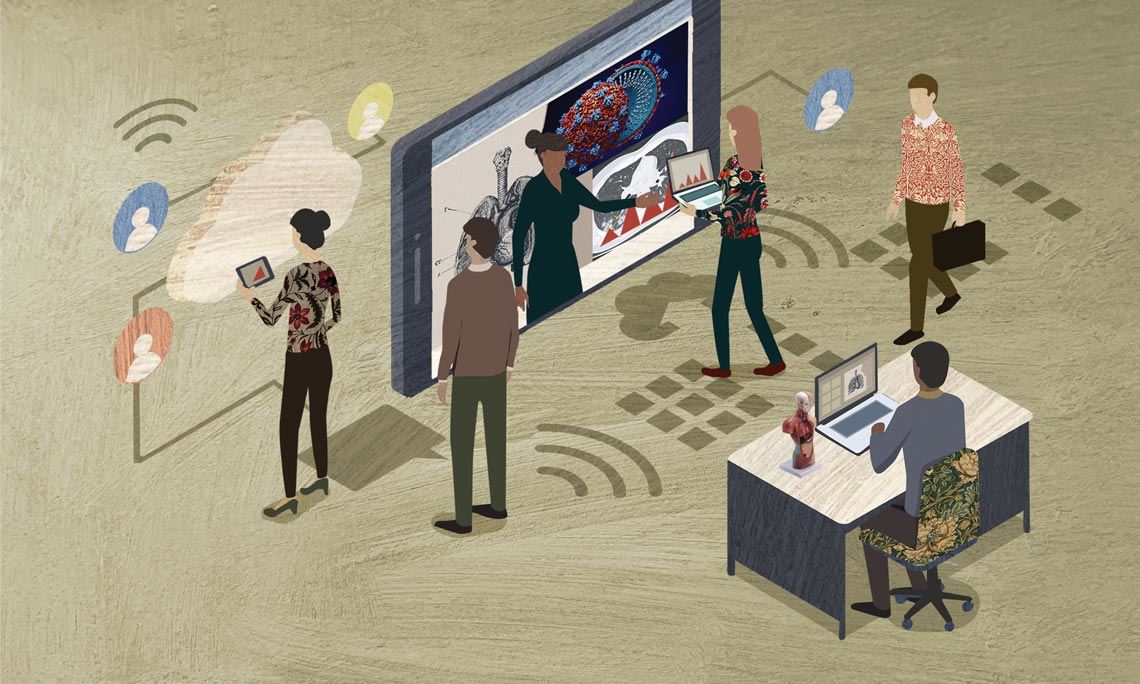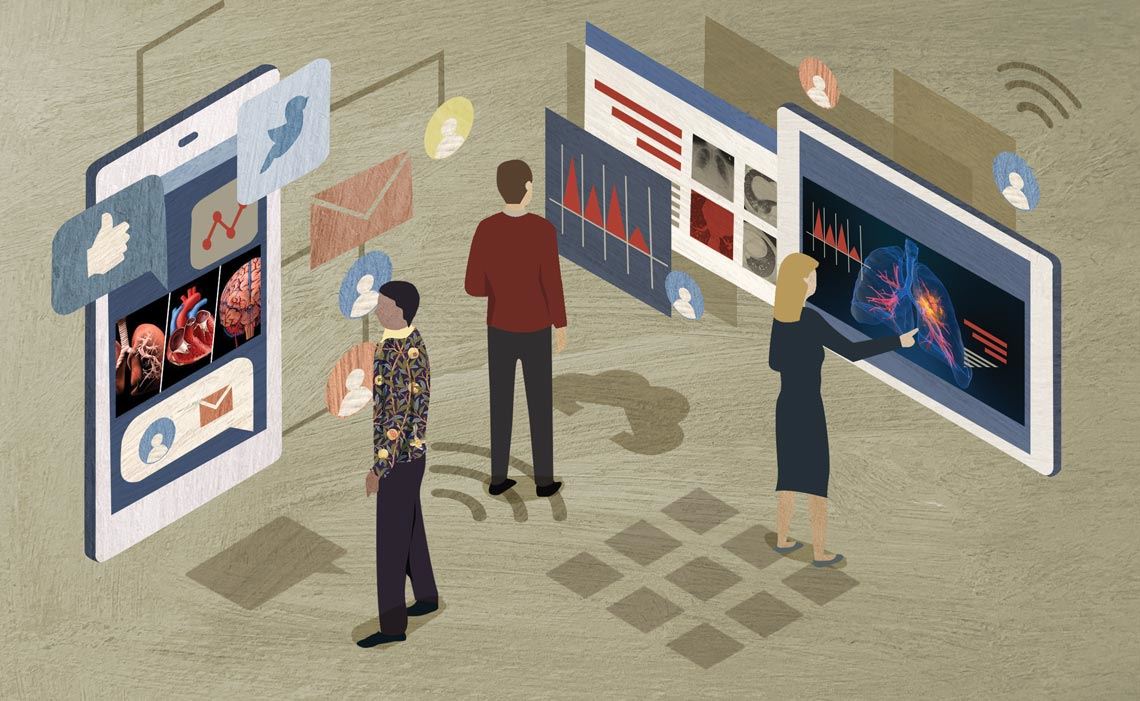With the risk of SARS-CoV-2 making face-to-face academic meetings impossible until at least the end of 2020, committees that organize conferences are turning to the internet as a new way of exchanging knowledge between members of the scientific community. “We realized that to avoid having to cancel meetings during this period of social distancing, we needed to hold events online,” explains Bianca Amaro, general research coordinator at the Brazilian Institute of Information in Science and Technology (IBICT) and a member of the organizing committee of the 11th Luso-Brazilian Open Science Conference, an international event focused on scientific knowledge access, exchange, and communication that alternates between cities in Brazil and Portugal.
With roughly 200 participants, this year’s conference was initially planned to take place in the city of Braga, Portugal. In March, when the quarantine began, the organizers started adapting it to an online format. “In terms of organization, there wasn’t much difference, since the processes for receiving papers, sending invitations, and contacting speakers were already done remotely,” says Amaro. One of the advantages of the new format is a significant reduction in expenses, with no need for physical tickets, accommodation, and rented space for the meeting, which takes place in the first week of October. “The good thing about online conferences is that it is easier for international speakers to participate,” she adds. Traditional events, such as the annual meeting of the Brazilian Society for the Advancement of Science (SBPC) and the National Association for Graduate Studies and Research in Social Sciences (ANPOCS), also switched to an online format to allow the activities planned for this year to go ahead.
• Wear plain clothes in neutral colors
• When speaking, try to look at the camera instead of the computer screen
• For a more immersive experience, use headphones and a microphone
• Try not to interrupt the speaker. Instead, interact via chat or other communication channels
• Do not leave the computer without warning, especially during smaller events
• Check the quality of your internet connection
• Turn off any nearby radios and televisions and put your cell phone on silent, to avoid interference
While virtual conferences offer advantages such as lower costs, they also present the challenge of an audience that in some cases is many times larger. Designed for around 300 participants, this year’s Anesthesiology Conference at the University of São Paulo (USP)—held by the anesthesiology department at the university’s School of Medicine (FM) since 2014—far exceeded expectations, with more than 7,500 participants. “It was a major challenge; as well as the fact that we had no previous experience with online events, the huge number of people interested was a great responsibility for the technical team,” explains FM-USP professor Claudia Marquez Simões, one of the organizers of the conference.
In the end, the event was so large that they had to hire a specialist contractor to help. “We didn’t want to risk using generic platforms whose services may not be fast or reliable enough,” says Simões. As well as taking on responsibility for the technical side of transmitting the conference, the external company was also in charge of the registration process and other important resources, such as simultaneous translation by specialists in the field. “In medicine, there are very specific terms that must not be misinterpreted, which rules out the automatic translation offered by some platforms,” explains Daniel Bruno Merello, owner of Medicine Cursos, an online health events and distance learning company. Since the start of the pandemic, the company has organized approximately one hundred online events, including scientific meetings, conferences, and forums.
Another medical event, FM-USP’s 5th Conference on Clinical Immunology and Allergies twice changed its date because of the pandemic, before the organizers decided to hold the meeting remotely. The event was broadcast online, but a physical space with a lectern and screen was hired for the speakers to present their topics and show images, slides, or power points. “We also created a 3D environment that simulated stands, allowing participants to move between the different spaces of the event,” explains Fábio Fernandes Morato de Castro, a member of the scientific committee and one of the organizers of the conference, held in September. Despite the innovative approach, Castro says that the event, which had about 800 participants, tried to keep things simple. “I have taken part in many online meetings due to the pandemic and I can say that the more elaborate they are, the greater the risk of something going wrong,” he says. As well as simplicity, good organization is also essential. “Every activity has to be planned in detail. Insufficient content or transmission failures are seen as less acceptable these days, and they can jeopardize the credibility of an event.”
Organizers of online conferences are continuously learning and over time, the approach is becoming more professional and established, which may prove useful for future events, even after the pandemic is over. “We will probably start seeing more hybrid events that combine physical and virtual attendance, rather than being in-person only. I would already say that this process is going to have permanent repercussions,” says Castro.
The growing number of online conferences taking place since the pandemic began has increased demand for specific services, beyond the simple transmission of video conversations. “With more than 2,300 academic meetings held since March, we now know that we need to develop virtual environments that make these events more attractive,” explains Geraldo de Oliveira Santos Neves Neto, one of the founders of Doity, a company located in Maceió, Alagoas, that specializes in virtual conferences and seminars. The company was Initially created to provide registration solutions for traditional in-person events, but now it also offers websites and applications for events, platforms for submitting scientific papers and issuing certificates, and communication and monitoring tools. In addition to the development of these interfaces, specialist lecture broadcast studios are beginning to emerge, hinting at the hybrid nature many conferences may assume over the coming years.
One of the major disadvantages of online meetings, however, is that they do not allow for unscheduled interactions, which usually occur spontaneously in the intervals between talks. “Many partnerships and collaborations are born from these informal moments during physical encounters,” acknowledges Amaro, from IBICT.
Online etiquette
While videocalls being invaded by children and pets was a cause for laughter among participants in the early days of the pandemic, the novelty has worn off after six long months of online meetings. “We have also realized that online events can be exhausting, especially when they feel like they are never going to end,” observes Marcelo Gameiro Munhoz of USP’s Institute of Physics (IF). A member of the organizing committee of the 43rd Working Meeting on Nuclear Physics in Brazil, scheduled for December, Munhoz highlights the need to establish—and comply with—maximum times for each presentation, as well as defining the most effective times for participant interaction. “If lectures are not well structured and the program is not well organized, attendees can lose interest even more quickly than at a face-to-face event,” he notes. How content is presented is another aspect that requires particular care. “Many speakers choose to read written presentations, which can be quite boring in a virtual environment.”
In order to avoid unnecessary interruptions that might push the lecture beyond the time limit, many events require the speaker to share their email address, via which they can respond to any questions or comments after the event is finished. To encourage interactions between the audience, many organizers enable a chat feature during presentations.
Ideal environment
Good organization of a virtual event’s broadcast space can improve the experience of participants. One common mistake is inadequate lighting, which can negatively affect video quality. “Natural light is one of the best resources for meetings taking place during the day,” says photographer and art director Paulo Pepe. When natural light is not available, ring lights of various sizes, which are easy to buy online or in stores, can be used to prevent unwanted shadows.
To take better advantage of the natural light from a window, for example, the speaker should position themselves at a 45 degree-angle to the window, at least 1 meter away from the wall, if possible. “Standing the speaker in front of a window is one of the most frequent mistakes, because it creates shadows that obscure their face,” he warns. Using a curtain to filter out excess light can also be a good technique, as is using a lamp when looking for a more natural effect. Another suggestion is to position the camera and computer screen at eye level, to avoid the sensation that the speaker is looking down.
Bookshelves in the background can be distracting if they are too close to the camera. “There are always people who will pay more attention to the books on the shelves than to what is being said,” says Pepe. He recommends making sure any books in the background are at least 2 meters behind the speaker. “A better option is to speak in front of plain walls, which are more discrete and do not generate as much noise in the transmitted image,” he concludes.
Republish
